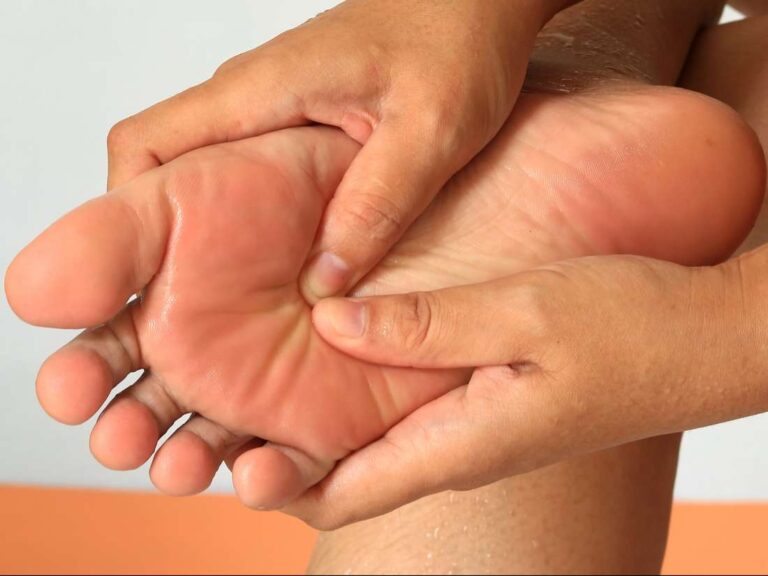Sores or blisters on the bottom of feet can emerge from several causes. Common causes are dyshidrotic Eczema or Athlete`s foot infections. Injuries or underlying diseases can also contribute to this unsympathetic condition. Symptoms can be mild, moderate or severe i.e. bleeding. Here, you`ll learn more about causes, symptoms, and remedies for this nerve-racking foot problem.
Causes of the bottom of feet sores
There are quite a number of causes resulting in sores under the feet. They can be external or internal foot conditions. The resultant symptoms definitely will be unpleasant to everyone. So accurate diagnosis should be done since if you know the exact cause, then a definition of effective treatment may be quite easy. Explore the following possible causes of sores on the bottom of feet:
Dyshidrotic eczema

This is a condition that leads to blisters on feet, hands or toes. The blisters have variant sizes and can burst to form extremely painful sores on the bottom of the feet. The exact causes for these types of eczema are not known but medical experts link it with seasonal allergies or stress.
This condition can be treated through the application of corticosteroid creams if more serious, corticosteroid injection or pills may be prescribed. Other treatments include antihistamines, immune-suppressing ointments, anti-itch creams, UV light therapies or even draining large blisters.
Home remedies are also available to relieve this condition.
Friction and burns
This is another common cause of bottom foot sores. Friction between socks/shoes and feet may result from tight shoes or repetitive rubbing. It can also be between foot and soil surface if you walk barefooted. Burns can also lead to fluid or blood-filled blisters that may burst to form sores. These can also get infected and aggravates the condition.
Treatments may involve painkillers, keeping the blister clean and protected, and antibiotics since the ruptured blisters can get infected.
Athlete`s foot infection
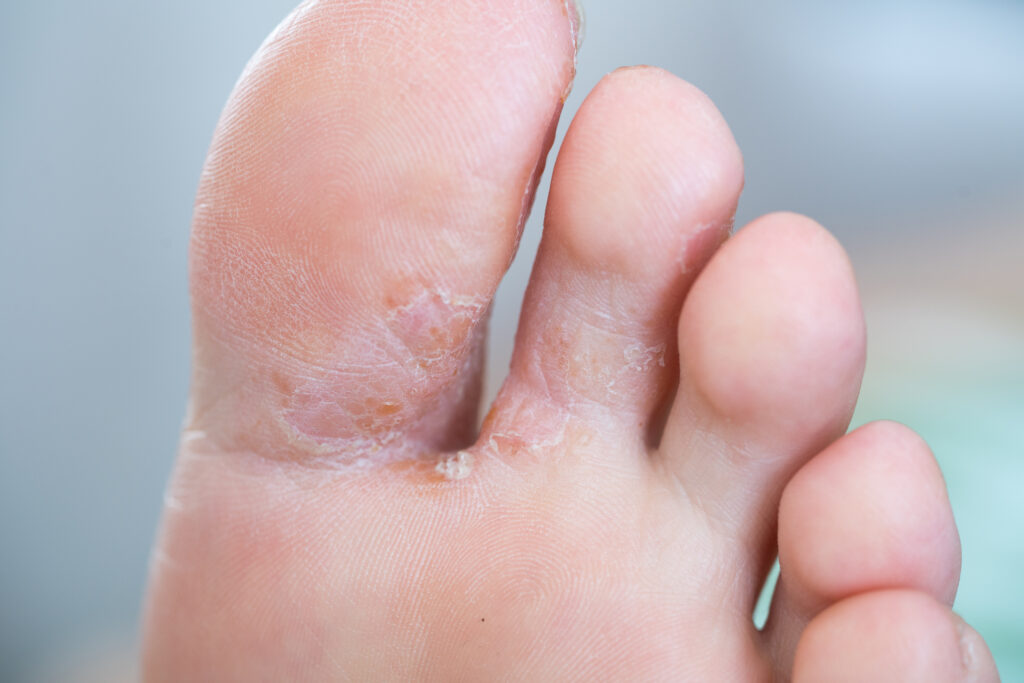
The athlete’s foot infection otherwise called tinea pedis is a foot infection that can lead to small blisters or sores on the bottom of the foot. This is actually a fungal infection that occurs when a certain fungus grows on foot skin. This is possible when the required survival standard for such fungus is met: that is a warm and moist place.
There are many conditions or behavior that can favor the survival of this infection, they include wearing one pair of sock/shoes more than once, prolonged exposure to a moist environment such as those people who carry out irrigation (with unprotected feet) or not washing your feet regularly. There are over the counter anti-fungal that can treat this infection. Your doctor can also prescribe other medicines.
Dry Feet
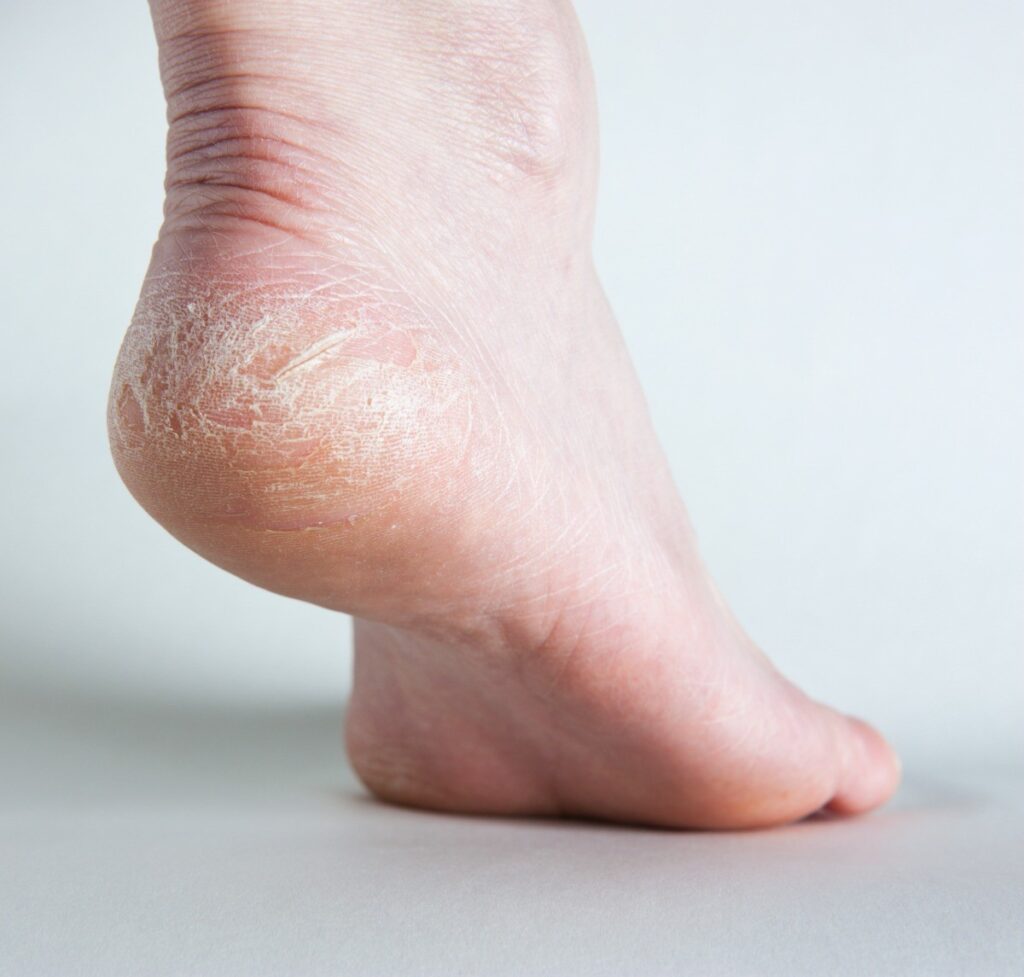
There are many factors that can lead to dry feet. This can be internal or external. Dry soles can easily peel, crack or flake. They can be due to weather, prolonged exposure to moisture, lack of miniaturization, underlying health conditions or certain medications. Good feet care and regular moisturizing is the best idea.
Contact dermatitis and poison ivy
Sores on the bottom of feet can also be due to contact dermatitis. It can be due to an allergic reaction or irritation to several irritants. There are several allergens and irritations that can be blamed. These can include chemicals and dyes used to manufacture shoes and socks, soaps and detergents, etc.
“Blisters can also form in reaction to poison ivy if the bottom of the foot is exposed” [livestrong.com.] the best treatment so far will involve lotions or creams containing calamine as well as oral or topical antihistamines.
Foot ulcers
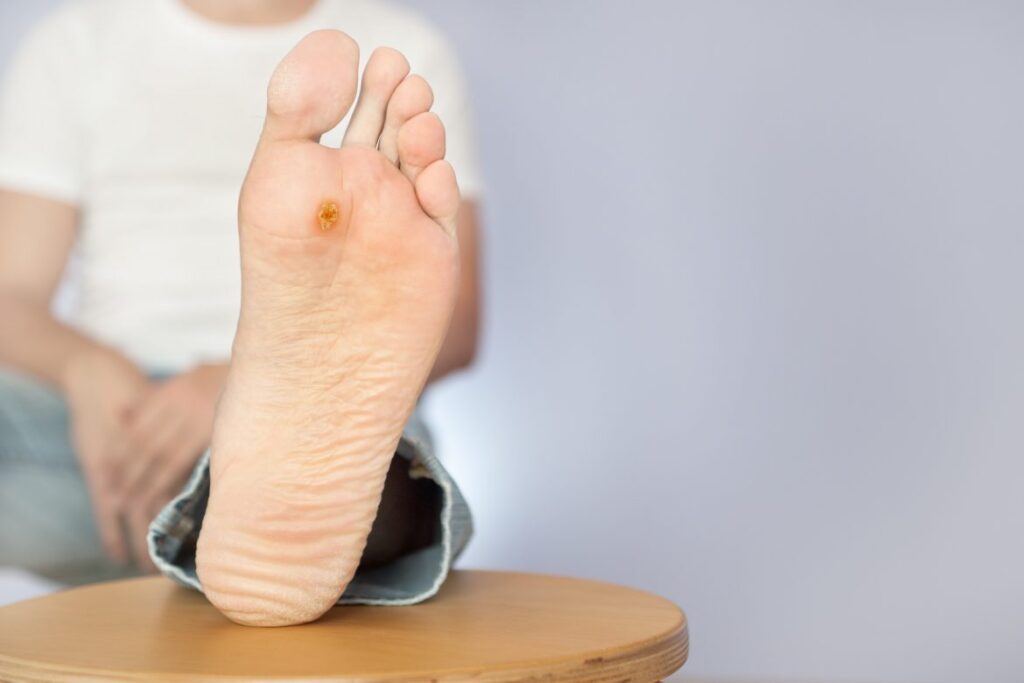
Foot ulcers are said to be a sore on the foot. These can be shallow or deep craters on the bottom of feet. They may be deep to the extent of spreading to the full thickness of the foot skin. This can affect also the bones, tendons as well as other deep foot structures.
Foot ulcers are common in people with Peripheral neuropathy, Circulatory problems, Abnormalities in the bones or muscles of the feet, Atherosclerosis, Raynaud’s phenomenon or diabetes.
The ulcers may be infected and may lead to dreadful complications such as cellulitis, abscess, osteomyelitis or gangrene. Treatments for this condition may involve treating the risks fast or treating the resultant symptoms straight away. They may include antibiotic injections, surgery, using medicated socks among others.
Metatarsal heads and sores
According to certain medical study, “One of the most common areas for blisters is under the ball of the foot.” This includes big or little toe knuckles. Actually, this is where metatarsal heads occur. This is weight-bearing bones that are usually subjected to high pressure.
During the time when the metatarsal skids over the skin and moves backward, the skin is stretched and compressed. Though this is normal to shear here, excessive shear may become unbearable. If this occurs near the surface of the skin, skin blisters may form at the bottom.
The best solutions are to resolve to cushioned insoles, ENGO blister patches, donut pads, etc. For severe conditions please see you GP.
Diabetes and foot sores
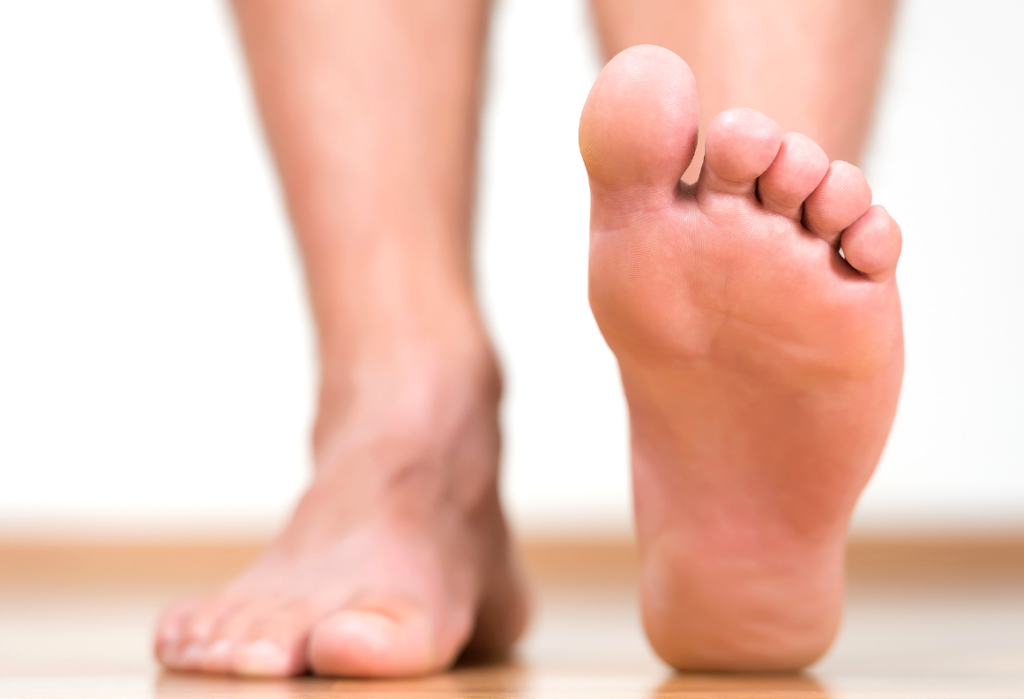
Food problems are common in diabetic people but it is possible to limit the chances of suffering from this giant. Diabetes may result in nerve damage and this can lead to tingling or pain on the bottom of the foot but again, you can lose feeling on the feet. If you lose feeling in the feet, you may not notice the pebbles or sharp objects in your socks or shoes. This may contribute to the bottom of foot cut or sores. This may thereafter be accompanied by lowered blood flow in the feet or secondary infections.
In the case of diabetes, you should see a specialist called podiatrist to attend to you. Other foot care tips should also be considered.
Reactive arthritis
This is a foot condition that can trigger inflammation in the skin, mouth, eyes, joints and urinary tract. Reactive arthritis or Reiter`s syndrome involves the immune system responding to bacterial infection. Livestrong.com explains that “A possible symptom includes tiny blisters developing on the soles of the feet and palms of the hands. The blisters may lead to flaking and peeling skin, which might look similar to psoriasis.”
Anti-bacterial and antihistamines treatments may be administered as the immediate treatments
More cause may include activities leading to sweating such as high fever or rigorous exercises or activities physical trauma is also not neglected. In children, hand, foot and mouth disease may also contribute. All the same, proper diagnosis is the best solution since it helps to establish good treatments.
Symptoms
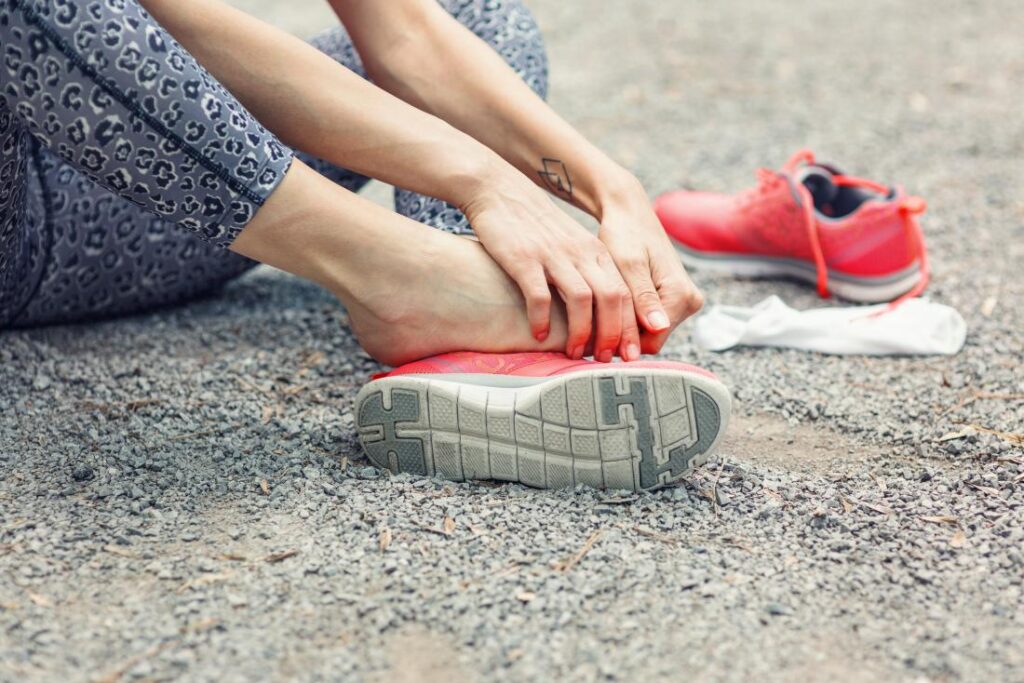
Several symptoms can occur alongside sores on foot soles, their severity will depend upon the underlying causes. They may vary in terms of size, depth or the duration they will take to heal. They may itch or be extremely painful. Again, the signs we are talking about may appear before the sores, during or after the occurrence of the sores. See the common symptoms listed below.
- Dry feet
- Small fluid-filled blisters
- Foot pain, itching or tingling sensations
- A spread of the sores in case of infections
- Difficulty in wearing socks or shoes. The same can be experienced when one walks
- Bleeding may also be experienced in moderate to severe foot conditions
- Skin reddening, swelling or tendering especially before the appearance of the actual sores
- Peeling, cracking or flaking may also be noticed in the soles
In situations where the sores on the bottom of feet are due to underlying medical or health conditions, some symptoms may be life-threatening or lead to unsympathetic complications. This is why we recommend that any of the above symptoms should be treated at their early stages, you never know they may aggravate and hence treatments may be advanced and complex.
Treatments for Sores on the Bottom of feet
To treat such kind of sores, there are two factors we have to consider. Treatment for underlying causes or treating the resultant symptoms. These may involve over the counter therapies, prescribed medicines or home remedies. Efforts to prevent infections must too be included. Here are the common treatments you can employ for your cases.
Moisturizing with oils
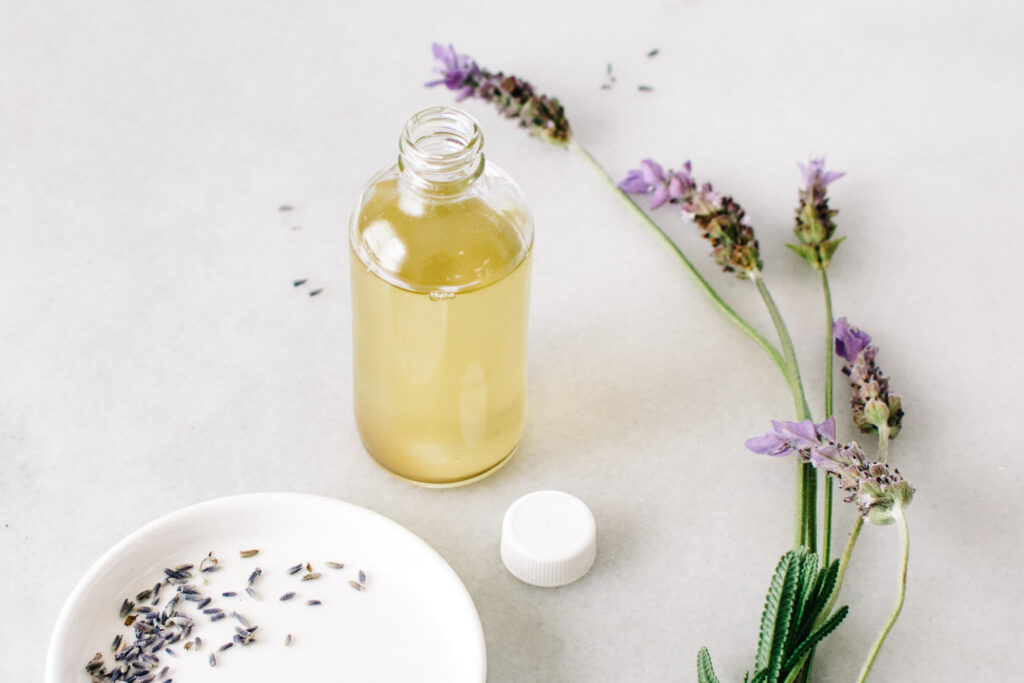
This is a very significant tip that prevents or relieves dry feet. Coconut, olive, lavender and almond are great moisturizers that treat dry feet or cracked soles that may develop sores. Soak your feet in warm water and then massage one or two of these oils on the foot and wear clean socks. This should be done overnight. Rinse off the oil the first thing in the morning. This process should continue until your foot condition heals.
Apple cider Vinegar
This has wonderful potential to remove dead skin cells. The acidic property also helps in preventing infections. You should begin by warming some generous amount of warm water and add some apple cider vinegar. Wash your feet using the solution and see the results.
Aloe Vera

Aloe vera has got applauded natural properties that can reverse damaged skin. Mix aloe vera with turmeric powder to form a complete paste. Massage the paste on your affected soles. This will help avoid or treat infections causing foot sores as well as relieving itching or inflammations.
Baking soda soak
Baking soda can help treat inflammation, infections and gently scrub the dead skin leaving behind the beautiful smooth skin. You soak your feet in baking soda solution for 20 minutes and then rinse with clean water. This should be repeated at least thrice a week until good results are achieved.
There are more home ingredients that can be applied but all you need to do is to select one option and use it according to and persistently.
Other tips to get rid these sores

Here is more to tips to prevent or treat the bottom of foot sores:
- Protect your foot from harsh weather i.e. cold or hot weather
- Wash your feet daily
- Wear shoes and shocks almost every time if possible
- You are able to examine every part of your feet daily
- You should also not forget good foot hygiene
- In case you suffer corns and calluses, you should consult the doctor for good care
- You should drink plenty amount of water daily to stay hydrated
- Avoid extreme sweating by removing your tight shoes or socks at some points
- You should avoid hot showers, this robs the skin its moisture
When to see a doctor
If your sores are not responding to the over the counter drugs or home remedies, then it is your time to see your doctor. He/she may have more treatment options to offer but remember this will be determined by proper diagnosis. The bottom of the feet sores are cruel and painful sores that must be given great care and medication.

